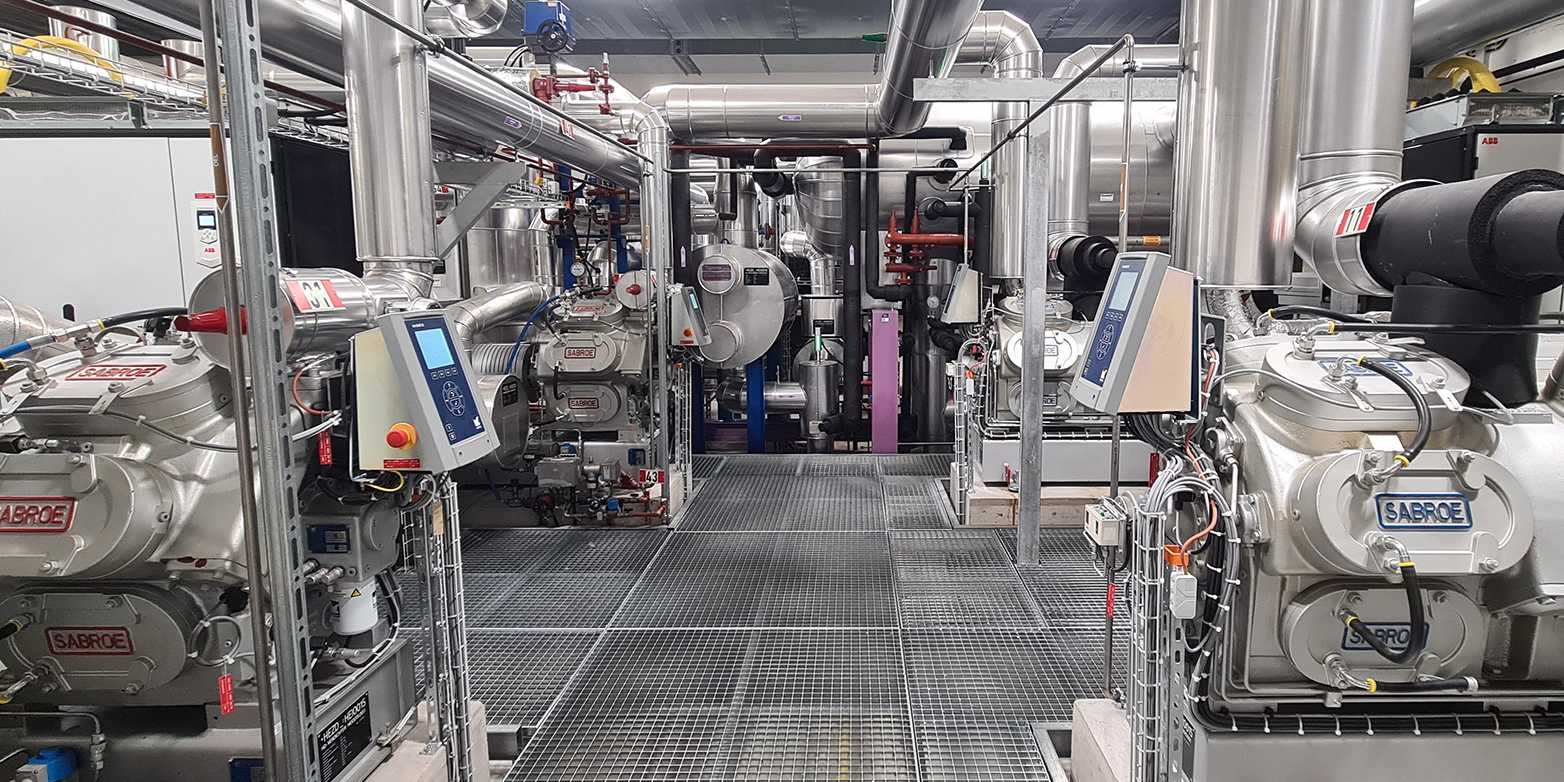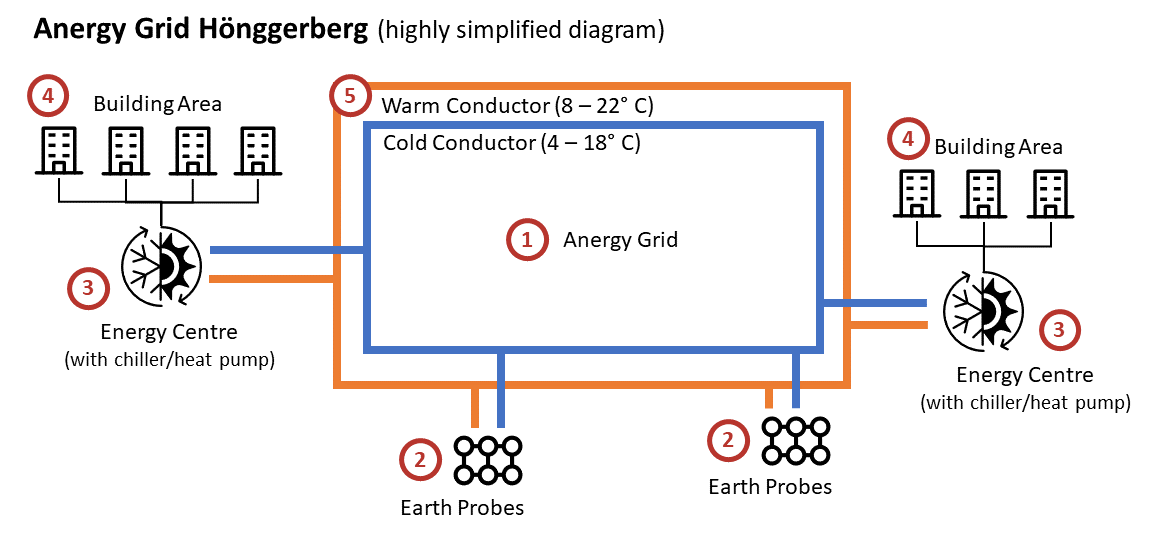The new equipment brings the Hönggerberg campus one step closer to efficient and environmentally friendly heating and cooling and helps to further reduce CO2 emissions and the consumption of fossil fuels.

In autumn 2023, the Real Estate, Facility Services and Engineering & Systems departments put a large chiller/heat pump into operation in the basement of the HEZ building on the Hönggerberg campus. The basics of the thermodynamic cycle remain the same, regardless of whether the machinery is generating cooling or heating (see box "Heat pump in a nutshell").
The HEI 15 (see picture above) is an impressive system with a heat output of up to 3.2 MW and a maximum cooling output of 2.8 MW. In winter, when the demand for heat is high, the heat pump supplies heating water at 50° and 80° Celsius. The standard output for cooling is 6° Celsius. Thanks to four individually controllable compressors, the machine can be adapted to current demand.
A second comparable system is already planned. For more flexibility, two more chillers will be added to the network at a later stage. The new systems will replace both old, less efficient equipment and existing fossil-fuelled boilers.
Heat pump in a nutshell
Heat pumps use environmental heat to vaporise a refrigerant (e.g., ammonia). Depending on the refrigerant, this also works at cold, even sub-zero temperatures. In a second step, the gaseous refrigerant is compressed. This requires electricity. The gas heats up during compression. A heat exchanger absorbs the heat energy and transfers it to the heating circuit. This cools the refrigerant, which liquefies, is then depressurised (expanded) and fed back into the circuit. The cooling process works in the same way, whereby the excess heat is dissipated to the environment at a higher temperature level.
Heat pumps are considered to be efficient because they generate a heat output many times greater than the electric drive power input. They are also considered environmentally friendly because there is no combustion and therefore no direct CO2 or particulate matter is emitted.
Integration into the anergy grid
All chillers/heat pumps are integrated into the Hönggerberg Anergy Grid (see chart below: 1). The anergy grid includes a dynamic underground storage system with earth probes (2), but also connects all the energy centres (3) of the various building areas (4) with an underground distribution loop (5), thus enabling intelligent linkage of heat sources and heat sinks.
The new HEI 15 chiller/heat pump is to leverage this advantage by selecting either the cold or the warm conductor (5) of the grid as input medium depending on current requirement (cooling or heating). This reduces power consumption and increases efficiency. The temperature in the two conductors always differs by around 4° Celsius and also fluctuates seasonally to take account of the increased cooling requirement in summer and the increased heating requirement in winter.
Stefan Kollischan from Central Supply Hönggerberg explains: “As an integrated system, the anergy grid with the new chiller and heat pumps enables a highly efficient and environmentally friendly heating and cooling supply.” At the same time, complexity is also increasing. Currently, the controls and software for the HEI 15 are being optimised for use on the Hönggerberg as the many parameters require comprehensive initial adjustment.
The Anergy Grid Campus Hönggerberg
The DownloadAnergy Grid Campus Hönggerberg (PDF, 2.7 MB) - a dynamic underground storage system and low-temperature distribution network - is a flagship project of ETH Zurich and was awarded the Swiss Watt d'Or energy prize in 2020. Planning began in 2006. It was put into operation in 2013 and has been continuously expanded ever since. Today it comprises five energy centres, known as clusters. The final expansion will be completed in 2040.
Expansion of renewable energy generation continues
The new chillers/heat pumps aim to reduce dependence on fossil fuels as well as CO2 emissions. When oil and gas prices are high, cost benefits are also possible. In the future, the Hönggerberg campus' heating requirement is planned to be covered entirely without gas and heating oil.
Nevertheless, ETH will continue to use fossil fuels. Certain processes depend on high temperatures from combustion – such as generating steam for sterilisation or the fire simulator. Moreover, ETH keeps a stock of fossil fuels to ensure security of supply. For example, the main energy centre on the Hönggerberg is home to two large diesel generators as a backup power supply.
As a result, traditional heat generators are still in operation on the Hönggerberg in addition to the modern HEI 15 chiller/heat pump. However, according to federal regulations, no more energy from fossil sources may be used by 2030. To achieve this goal as well as ETH's own net zero targets, ETH is currently working on the energy concept of the future. Carbon capture, i.e. the removal of emissions from the flue gas of combustion processes, will also play a role in this.
Note on the translation
This text has been translated for your convenience using a machine translation tool. Although reasonable efforts have been made to provide an accurate translation, it may not be perfect. If in doubt, please refer to the German version.
Should you come upon significant translation mistakes, please send a short message to so that we can correct them. Thank you very much.
Always up to date
Would you like to always receive the most important internal information and news from ETH Zurich? Then subscribe to the "internal news" newsletter and visit Staffnet, the information portal for ETH employees.

